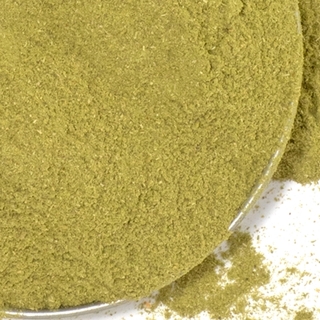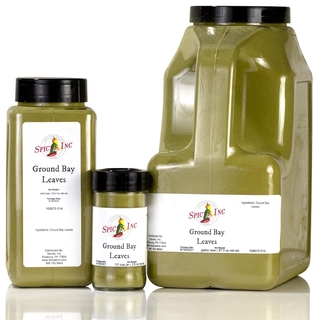Ground Bay Leaves




Ground Bay Leaves
Ground Bay Leaves, Laurus nobilis, are also known as bay leaf powder, ground bay leaf, bay leaf substitute, bay leaf powder, or bay powder. They have an essential oil content of .8% - 3.0%.
Bay leaves most likely originated in South Asia, then spread through the Middle East to Turkey. From there they came to Italy and Greece, where they were valued both for their flavor and, being evergreen, as a symbol of strength, vigor, and protection.
Ground Bay Leaves are popular with:
- seasoning companies;
- brewpubs;
- seafood, pizza, American, and Mexican restaurants;
- independent spice shops;
- sauce and subscription manufacturers;
- catering companies; and
- butcher shops
We also have whole Organic Bay Leaves available.
One Dried Bay Leaf = ¼ tsp Ground Bay Leaves
Flavor Profile
Ground Bay Leaves taste bitter, spicy, and piney with hints of nutmeg, clove and muted camphor-like notes.
How To Use
Ground Bay Leaves have been long been used in cooking, and this versatile herb is used in wide range of dishes, sauces, and condiments. Bay Leaves can also be a key ingredient in cheese, liquors, oils, and teas. Its essential oil is used commercially in beverages, dental products, perfumes, prepared foods, and soaps.
Bay Leaves are featured in Creole, Italian, and Spanish cooking where they are commonly added to flavor fish and shellfish dishes, such as bouillabaisse. They are an excellent addition to many pickling brines, sauces, soups, and stews.
Bay Leaves are good with beef, chicken, citrus fruits, fish, game, lamb, lentils, rice, tomatoes, white beans, soups and stews.
Bay Leaves work well in combination with allspice, garlic, juniper, marjoram, oregano, parsley, sage, savory and thyme.
| Also Called | Bay leaf powder, ground bay leaf, bay leaf substitute, bay leaf powder, or bay powder |
| Species | Laurus nobilis |
| Ingredients | Ground bay leaves |
| Flavor Profile | Bitter, spicy, piney, hints of nutmeg, clove and muted camphor-like notes |
| Oil content | .8% - 3.0% |
| Recommended Uses | Soups, stews, fish, shellfish, sauces, brines, beef, chicken, lamb, wild game, lentils, white beans |
| Cuisine | Global |
| How To Store | Airtight container in a cool, dark place |
| Shelf Life | 6-12 months |
| Country of Origin | Turkey |
Nutrition Facts
Serving Size1 tsp
Amount Per Serving
Calories8
% Daily Value*
Total Fat0g0%
Saturated Fat0g0%
Trans Fat0g
Polyunsaturated Fat0g
Monounsaturated Fat0g
Cholesterol0mg0%
Sodium0.6mg0%
Total Carbohydrate1.8g1%
Dietary Fiber0.6g3%
Total Sugars0.0g
Added Sugars0g0%
Sugar Alcohol0.0g
Protein0.2g0%
Vitamin D0mcg0%
Calcium20mg2%
Iron1mg6%
Potassium13mg0%
*The % Daily Value (DV) tells you how much a nutrient in a serving of food contributes to a daily diet. 2,000 calories a day is used for general nutrition advice. These values were calculated and therefore are approximate. For more accuracy, testing is advised.
